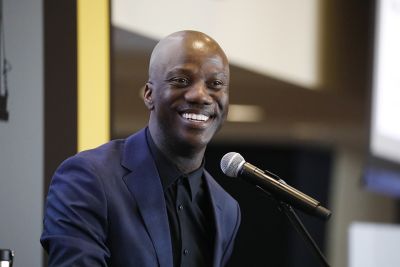Beideman Visiting Scholar Outlines Steps to take Diversity, Equity, and Inclusion to the Next Level

How does a college or university take its commitment to diversity, equity, and inclusion to the next level? How does an institution purposefully work toward being more anti-racist?
For Shaun Harper, it means moving far beyond trendy performative statements, one-off professional development workshops, or just the commitment to increase the number of diverse students, faculty, and staff on a particular campus.
To truly progress toward a more racially equitable and just campus, colleges and universities must commit to long-term, sustainable work, guided by data and strategy grounded in action.
“It’s not enough to declare these things matter to the institution. You have to hold folks accountable,” said Harper, one of the nation’s most highly respected racial equity scholars, who spoke to the Widener community on Jan. 14 as the 2022 Beideman Visiting Scholar.
Harper, provost professor in the Rossier School of Education and the Marshall School of Business at the University of Southern California, is the founder and executive director of the USC Race and Equity Center.
The center conducts campus climate surveys of students and employees across the country, asking people about the “realities and complexities of race and the racial climate” at their institutions. From these surveys, Harper and his team have noted a number of trends and common experiences, and have developed strategies that institutions can follow to advance their commitment to being antiracist.
Harper shared these points during the lecture.
Some of the common student experiences reported in their surveys include: black students being called the N-word by a white person on their campuses; curriculum that does not include the history and culture of people of color; white students, therefore, being racially illiterate and entering the world not understanding the experiences of people of color; class conversations on race being approached from a deficit perspective, while students of color find themselves being the forced spokesperson for their racial group; and visible segregation of students in campus spaces.
Desirée Israel, a second-year student in Widener’s social work doctoral program, found Harper’s lecture very much on point. Several of the national survey results hit home for Israel, a woman of color who has experienced “being tokenized in class.” For instance, if a class is discussing race and oppression, there’s an expectation that “certain people are expected to speak first,” said Israel.
Israel, a therapist, has also experienced the issue of deficit perspective in her discipline.
“There’s a deficit in the curriculum. It’s social work as a whole, not just Widener. When speaking to black families it’s in a deficit manner rather than in the affirmative.”
“And there’s a lack of color in social work pedagogy,” said Israel, though she notes that her Widener professors have taken time to integrate diverse ideas and perspectives into their syllabi.
Harper’s lecture also resonated with Widener clinical psychology doctoral student Megan Airey, who is conducting a practicum this semester at another university’s college counseling center. Airey has worked with students struggling with depression and anxiety, and has come to discover, through sessions, that racism and racial trauma is a contributing factor.
Airey, who hopes to work with this demographic when she completes her degree, said the practicum experience, and hearing of Harper’s survey results, underscore the importance of having “open, honest, and frank conversations” with clients.
The common college employee experiences reported in Harper’s surveys include: being the only person of color in a department or unit, and the pressure to be the spokesperson for their racial group; the disproportionate service burden they experience because there’s so few faculty of color; feeling invisible and hypervisible at the same time; imposter syndrome; the exhaustion employees of color experience because they’re constantly having to fight for change; and intersectionality.
“It’s not only recruiting more diverse faculty and staff, but how to support them and retain them,” said Harper. “Diversifying the workforce on its own is insufficient. You need a robust ecosystem of support.”
So how does a college or university become more anti-racist?
Harper outlined 10 steps, which include assessing the climate and using the data to develop a multidimensional strategy to take action; evaluating the curriculum and working to integrate race and justice topics across disciplines; denouncing white supremacy and racism in all its forms; specifying racial equity in DE&I efforts; and investing in professional learning experiences that develop racial literacy and can help sustain the DE&I climate.
Harper’s call for action left a mark with international relations student Nigel Kaseke ’25, who grew up in Zimbabwe and South Africa.
“We have to be really conscious of what we do, and our actions have to be really intentional,” said Kaseke.
The Beideman Visiting Scholar program brings world-class speakers and scholars to the Widener campus on an annual basis to stimulate discussions on current and pertinent theories and practices related to leadership development and the effective exercise of leadership. The program is made possible by a generous gift from alumnus Paul Beideman, chair of Widener’s Board of Trustees, and his wife Caroline.



